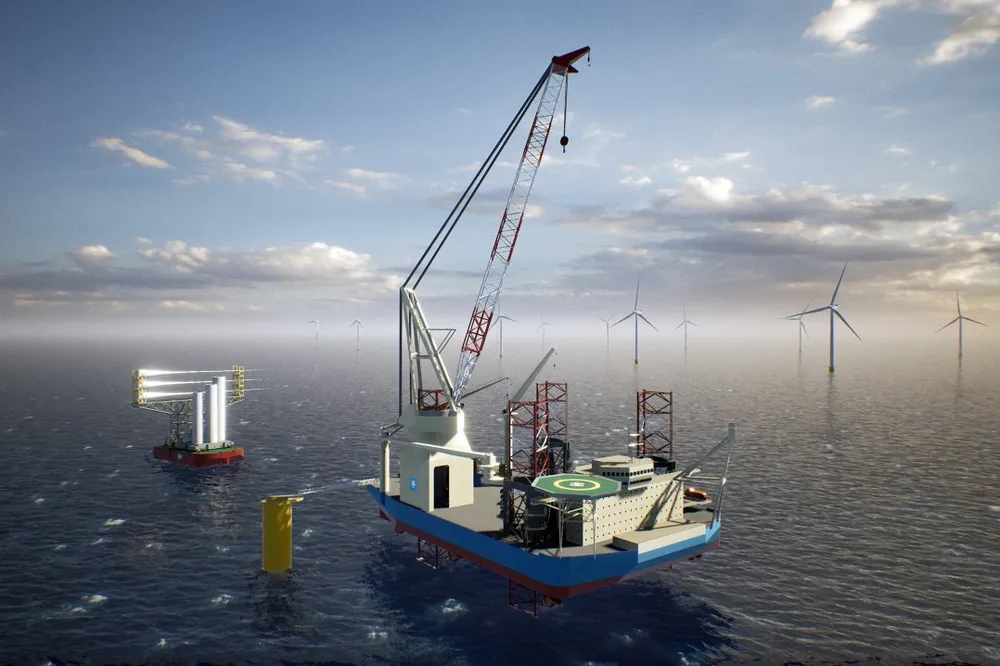'It looked so good': What now for Maersk's Jones Act-friendly wind vessel in Trump's US?
Maersk Offshore Wind's first turbine installation vessel was designed for an American market that has suddenly lost its appeal

An installation concept that Maersk Offshore Wind developed as an efficient solution for building projects in compliance with the US Jones Act can be successfully deployed in alternative markets amid turmoil in the American sector, the company believes.
Maersk Offshore Wind — a spin-off from the 2024 merger of Norway’s DOF Group and Denmark’s Maersk Supply Service — is poised to introduce a novel vessel concept called the Maersk WIV.
Under this concept, the vessel remains permanently stationed at the wind farm during the entire installation period, while purpose-built tugs and barges shuttle back and forth with the wind turbine components from the load-out port.
Delivery of the first Maersk WIV is expected from Singapore’s Seatrium shipyard at the end of this year, and the vessel has been lined up to carry out turbine installation for Equinor’s Empire Wind 1 offshore wind farm, serving New York.
The Maersk WIV will remain beyond the coastal shipping zone that restricts the use of foreign-built vessels, thereby remaining in compliance with the Jones Act, and will be "fed" by a US-built spread of tugs and barges.
Both the Maersk WIV and purpose-built feeder vessels are being equipped with locking and stabilising technology for safe operations in harsh environments, aiming to reduce the number of days required for wind farm installation, according to Maersk.
Maersk partnered with Louisiana-based Edison Chouest Offshore for the construction and operation of the four-vessel feeder fleet, known as the spread, being built by US shipyard group Bollinger Shipyards.
This spread is contracted for delivery for Empire Wind 1 for Equinor Offshore New York by July 26.
If all goes to plan, CEO Michael Reimer Mortensen, said the company is hoping to carry out its first connection tests with tugs and barges in either February or March 2026.
But the uncertainty now hanging over offshore wind in the US since President Donald Trump issued a string of executive orders against the industry, has impacted plans, acknowledges Mortensen.
"We were focused on getting into the US wind market with a unique wind installation concept offering efficient installation and full Jones Act compliance," he told a SpareBank energy investment conference in Oslo.
"This is a fantastic, innovative vessel that we are doing. Just five months ago, it looked so good that we were almost ready to put another spread into the US," he said.
"Fast forward five months, and you don't need to do that many calculations to conclude that the timing was probably not that right," he admitted, pointing out that projects of this nature normally require a construction period of three or four years.
President Donald Trump made it one of his priorities upon taking office to suspend offshore wind leases and pause a range of other approvals, triggering losses and headlong retreat in much of the sector.
So long America?
But Maersk Offshore Wind reckons that the scope for reducing installation time and cost goes beyond Jones Act compliance and, according to Mortensen, the feeder model can reduce the installation time of offshore wind turbines by almost one-third.
"It will require OEMs and other players in the industry to think differently about both the installation and the logistics, because it is a different setup, but we actually also believe it can work in Europe, Asia-Pacific, and other places," he said.
Benefits claimed by Maersk Offshore Wind include a reduction in the amount of time spent on mobilisation and logistics, with lower port costs, and the enabling of earlier generation of power and faster connection to the grid.
At the heart of the bespoke offshore feeding system is the WIV which features a 1,900-tonne crane and lifting system reaching 180 metres above the deck and able to can install 20MW-plus wind turbines.
"We want to look for pockets in the industry where we can basically be different, but also where we can actually help drive down costs of putting up turbines," Mortensen said, adding that the company was also engaging with the group's Maersk Project Logistics arms to explore efficiencies in transport and logistics.
(Copyright)